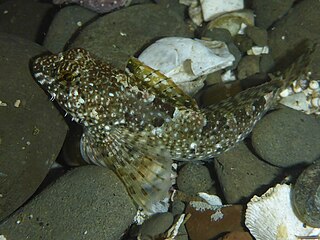
The snubnose sculpin is a species of marine ray-finned fish belonging to the family Cottidae, the typical sculpins. This fish is found in the eastern Pacific Ocean.

The Norway bullhead is a species of marine ray-finned fish belonging to the family Cottidae, the typical sculpins. This species is found in the northeastern Atlantic Ocean.

Clinocottus globiceps, the mosshead sculpin or globe-headed sculpin, is a species of marine ray-finned fish belonging to the family Cottidae, the typical sculpins. This sculpin is found in the northeastern Pacific.

Clinocottus is a genus of marine ray-finned fishes belonging to the family Cottidae, the typical sculpins. They are nearshore benthic fishes native to the northeastern Pacific Ocean. They are mentioned as sharpnose sculpins.
The Andriyashev largeheaded sculpin is a species of marine ray-finned fish belonging to the family Cottidae, the typical sculpins. This species is found in the northwestern Pacific Ocean. This monospecific genus, and therefore this species, are known from a single specimen, the holotype. This was collected from off Simushir Island in the Kuril Islands at a depth of 100 metres (330 ft). That specimen had a total length of 23.6 cm (9.3 in) long. FishBase classifies this taxon within the Cottidae but other authorities classify it within the subfamily Psychrolutinae of the family Psychrolutidae. The genus name Andriashevicottus includes a patronym, the person honoured was not identified by the describer Fedorov, however, it is almost certainly the Soviet ichthyologist Anatoly Petrovich Andriashev, the patronym is suffixed with Cottus, the type genus of the family Cottidae. The specific name megacephalus means "big head".
Argyrocottus is a monospecific genus of marine ray-finned fish belonging to the family Cottidae, the typical sculpins. Its only species is Argyrocottus zanderi which is found in the northwestern Pacific Ocean from Japan to the Kuril Islands and in the Sea of Japan. It is found at depths of from 0 to 85 metres. This species grows to a standard length of 9 centimetres (3.5 in). This taxon was first formally described in 1892 by the Russian zoologist Solomon Herzenstein with its type locality given as Korsakov on Sakhalin in the Sea of Okhotsk. The 5th edition of Fishes of the World classifies the genus Argyrocottus within the subfamily Cottinae of the family Cottidae, however, other authors classify the genus within the subfamily Myoxocephalinae of the family Psychrolutidae. although others place the subfamily Myoxocephalinae within the Cottidae.

Artediellus is a genus of marine ray-finned fishes belonging to the family Cottidae, the typical sculpins. Most of the fishes in this genus are found in the northern Pacific Ocean but they also occur in the Arctic and North Atlantic Oceans.

Bero elegans is a species of marine ray-finned fish belonging to the family Cottidae, the typical sculpins. This species is found in the northwestern Pacific Ocean. This species grows to a length of 20 centimetres (7.9 in) TL. It is the only known member of the genus Bero.

The roughback sculpin is a species of marine ray-finned fish belonging to the family Cottidae, the typical sculpins. This species is found in the eastern Pacific Ocean. The roughback sculpin is the only known member of the genus Chitonotus.

Enophrys is a genus of marine ray-finned fishes belonging to the family Cottidae, the typical sculpins. These fishes are found in the northern and eastern Pacific Ocean.

Icelinusis a genus of marine ray-finned fishes belonging to the family Cottidae, the typical sculpins. These fishes are found in the northern and eastern Pacific Ocean.
The lavender sculpin is a species of marine ray-finned fish belonging to the family Cottidae, the typical sculpins. It is found in the eastern Pacific Ocean.

Megalocottus is a small genus of marine ray-finned fishes belonging to the family Cottidae, the typical sculpins. These fishes are found in the western Pacific Ocean.

Microcottus is a small genus of marine ray-finned fishes belonging to the family Cottidae, the typical sculpins. These fishes are found in the northern Pacific Ocean.

Oligocottus is a genus of marine ray-finned fishes belonging to the family Cottidae, the typical sculpins. These sculpins are found in the northern and eastern Pacific Ocean.
Phasmatocottus is a monospecific genus of marine ray-finned fish belonging to the family Cottidae, the "typical" sculpins. The only species in the genus is Phasmatocottus ctenopterygius from the northwestern Pacific.

Alcichthys is a monospecific genus of marine ray-finned fish belonging to the family Cottidae, the "typical" sculpins. The only species in the genus is Alcichthys elongatus, which occurs in the northwestern Pacific Ocean.

Artedius harringtoni, also known as the scalyhead sculpin or plumose sculpin, is a demersal species of marine ray-finned fish belonging to the family Cottidae, the typical sculpins. The species is native to the eastern Pacific.

Artedius lateralis, also known as the smoothhead sculpin or round-nosed sculpin, is a species of marine ray-finned fish belonging to the family Cottidae, the typical sculpins. The species, commonly found in the intertidal zone and to depths of 43 feet, is native to the northern Pacific, from Russia and the Bering Sea to Baja California. Growing to a length of 14 centimeters, it takes its name from the lack of scales on its head.

The woolly sculpin is a species of marine ray-finned fish belonging to the family Cottidae, the typical sculpins. It is found in the eastern Pacific Ocean, where it occurs along the coastline of California and Baja California.

















